Tea (meal)
Tea (in reference to food, rather than the drink) has long been used as an umbrella term for several different meals. Isabella Beeton, whose books on home economics were widely read in the 19th century, describes afternoon teas of various kinds, and provides menus for the "old-fashioned tea", the "at-home tea", the "family tea", and the high tea.[1] Teatime is the time at which the tea meal is usually eaten, which is late afternoon to early evening, being the equivalent of merienda.[2] Tea as a meal is associated with the United Kingdom, and the Republic of Ireland, and some Commonwealth countries. Some people in Britain refer to their main evening meal as "tea" rather than dinner or supper. This article is instead concerned with the various types of secondary, lighter, meals called "tea".
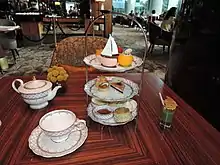
| Part of a series on |
| Meals |
|---|
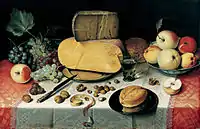 |
| Meals |
| Components and courses |
| Related concepts |
As a secondary meal, the timing of tea has moved over time in response to the moving later and later of the main dinner. Until the late 18th century dinner was eaten at what we now call "lunchtime", or in the early afternoon; supper was a later and lighter meal. Gradually dinner began to migrate, amid much controversy, until by about 1900 it arrived at its present timing in the evening. The earliest "tea" meals were often in the early evening, some three or four hours after dinner, or even later, after a supper and before bed. The philosopher Thomas Carlyle and his wife invited guests for 7 pm to their teas in the 1850s, although afternoon tea before dinner was also becoming established by this time.[3]
The most common ingredients of a light tea are tea itself, with cakes, biscuits or pastries (especially scones), bread and jam, and perhaps sandwiches; these are the ingredients of "traditional afternoon tea" meals offered by expensive London hotels.[4] But there may be other types of both drink and food offered or eaten at home.
Afternoon tea
Afternoon tea is a light meal typically eaten between 3:30 pm and 5 pm. Observance of the custom originated amongst the wealthy social classes in England in the 1840s,[5] as the time of dinner moved later. Anna Maria, Duchess of Bedford, is widely credited with inventing afternoon tea in England as a late-afternoon meal whilst visiting Belvoir Castle in Leicestershire. By the end of the 19th century, afternoon tea developed in its current form and was observed by both the upper and middle classes. It had become ubiquitous, even in the isolated village in the fictionalised memoir Lark Rise to Candleford, where a cottager lays out what she calls a "visitor's tea" for their landlady: "the table was laid… there were the best tea things with a fat pink rose on the side of each cup; hearts of lettuce, thin bread and butter, and the crisp little cakes that had been baked in readiness that morning."[6]
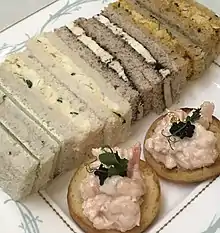
For the more privileged, afternoon tea was accompanied by thinly-sliced bread and butter, delicate sandwiches (customarily cucumber sandwiches or egg and cress sandwiches) and usually cakes and pastries (such as Battenberg cake, shortbread petticoat tails, or Victoria sponge). Scones (with clotted cream and jam) may also be served (as they are for cream tea). The sandwiches are usually crustless, cut into small segments, either as triangles or fingers, and pressed thin. Biscuits are not usually served. The English afternoon tea blend is medium body and lighter than English breakfast tea.[7]
Nowadays, a formal afternoon tea is more of a special occasion, taken as a treat in a hotel. The food is often served on a tiered stand; there may be no sandwiches, but bread or scones with butter and jam, or toast, muffins or crumpets.[8][9][10] Afternoon tea as a treat may be supplemented with a glass of Champagne or a similar alcoholic drink. This is a more recent innovation.
A less formal establishment is known as a teahouse or tearoom, similar to a coffeehouse. These used to be common in the UK, but these establishments have declined in popularity since the Second World War. A.B.C. tea shops and Lyons Corner Houses were successful chains of such establishments, and played a role in opening up possibilities for Victorian women. A list of significant tea houses in Britain gives more examples.
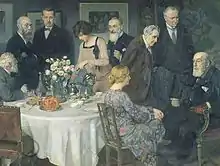
The custom of taking afternoon tea with bread or pastry was also common in some continental European areas, though such customs are not widely known in English-speaking countries. For example, Alexandre Balthazar Laurent Grimod de La Reynière wrote in 1804 of afternoon tea in Switzerland:
Vers les cinq heures du soir, la maîtresse de la maison fait elle-même, au milieu du salon, du thé très-fort, qu’adoucissent à peine quelques gouttes d’une crème onctueuse; de larges tartines de pain beurré l’accompagnent. Tel est le Thé suisse dans toute sa simplicité. Mais, dans la plupart des maisons opulentes, on y ajoute du café, des pâtisseries légères de toute espèce, et dont plusieurs sont même inconnues à Paris, des fruits confits ou glacés, des macarons, des biscuits, du nougat, et même jusqu’à des glaces.[11]:54
[Towards five o'clock in the evening, the mistress of the house, in the midst of the sitting-room, makes tea herself, very strong and barely sweetened with a few drops of rich cream; generous slices of buttered bread accompany it. Such is the Swiss Tea in all its simplicity. In most opulent houses, however, coffee and light pastries of all kinds are added, many of which are unknown in Paris, preserved or candied fruits, macaroons, biscuits, nougat, and even ice cream.]
A tea party is a social gathering around this meal – not to be confused with the Boston Tea Party, a mid-December 1773 incident at the beginning of the American Revolution, or the 21st century political movement named after it.
Cream tea
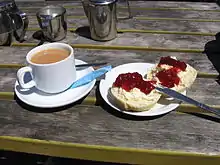
This snack is associated with the West Country, i.e. Cornwall, Devon, Dorset and Somerset. It usually consists of scones, clotted cream, strawberry jam, plus, of course, tea to drink. Some venues will provide butter instead of clotted cream. In Australia, this is commonly referred to as Devonshire Tea.
Evening high tea
High Tea is a name for an evening meal, sometimes associated with the working class but in reality enjoyed by all social classes, in particular after sports matches, especially cricket. It is typically eaten between 5 pm and 7 pm. This was also sometimes called a "meat-tea" in the past.[12] In most of the United Kingdom (namely, the North of England, North and South Wales, the English Midlands, Scotland, and some rural and working class areas of Northern Ireland) people traditionally call their midday meal dinner and their evening meal tea (served around 6 pm), whereas the upper social classes would call the midday meal lunch or luncheon and the evening meal (served after 7 pm) dinner (if formal) or supper (if informal).[13] This differentiation in usage is one of the classic social markers of English (see U and non-U English). However, in most of the South of England, the midday meal is almost universally called "lunch", with "dinner" being the evening meal, regardless of social class.
High tea typically may consist of a hot dish, followed by cakes and bread, butter and jam or to start cold cuts of meat, such as ham salad. The term was first used around 1825, and "high" tea is taken on a high (dining) table; by contrast, low tea, which was more of a light snack, was served on a low table – what would be called a coffee table in North America.[14][15][16]
A stereotypical expression "You'll have had your tea" is used to parody people from Edinburgh as being rather stingy with hospitality.[17] A BBC Radio 4 comedy series of this name was made by Graeme Garden and Barry Cryer.
Tea break
Not a meal as such, but a chance to "down tools" (or get away from the computer) and relax from work for 10–15 minutes. This may occur mid-morning (see elevenses) or mid-afternoon. It may equally involve coffee, and almost inevitably, biscuits. Around the second World War, the drinks were served by the workplace's tea lady, a position that is now almost defunct. The British and Irish habit of dunking biscuits in tea has been exported around the globe.[18]
Tea as the main evening meal
The term "tea" is often used among the British working classes, particularly those of the North of England and the South Wales Valleys, as signifying the main meal of the evening; this use of the word is also common in Australia. Other than the name, the meal is not different from those eaten as dinner or supper. More generally, a high tea was and is often the last meal of the day for young children, before an early bedtime.
Australian and New Zealand usages of "tea"
In Australia and New Zealand, a small informal social gathering usually at someone's home for tea and a light meal (i.e. biscuits, scones, or slices of cake or sandwiches) in the afternoon is referred to as "afternoon tea." The term high tea has been incorrectly used to describe the more formal event that is afternoon tea; however, it’s properly called afternoon tea, or low tea. Afternoon teas are often held outside the private home in commercial tea rooms, function venues, hotels, or similar.[19]
A tea break is the term used for a work break in either the morning or afternoon for a simple cup of tea or other beverage. In both Australia and New Zealand, a smoko, originally meaning a cigarette break, is also used as slang for a tea break, especially for people working in manual work.
In Australia and New Zealand the evening meal is still often called tea, whereas the midday meal is now commonly called lunch. In rural areas, dinner is still used quite often for the midday meal; tea is around 6 pm, and the term supper is either a late meal at night, or food served at night at a social function, such as the town's annual Christmas dance and supper. These phraseologies have fallen somewhat out of favour amongst young people.
See also
References
- Beeton, Isabella (1898). "Tea". Mrs Beeton's Cookery Book and Household Guide (New and Greatly Enlarged ed.). London: Ward, Lock & Co., Ltd. pp. 263–264. Retrieved 13 March 2019 – via Google Books.
- Copeman, Dawn (2006). "It's Time for Tea". Time Travel Britain. Retrieved 13 March 2019.
- Flanders, 229-231
- Teas at the Ritz Hotel, London
- p. 209, Pool, Daniel (1993) "What Jane Austen Ate and Charles Dickens Knew", Touchstone/Simon & Schuster, New York
- Pettigrew, Jane (2001). A Social History of Tea. London: The National Trust. pp. 102–5.
- Richardson, Bruce (16 January 2018). "Understanding Tea Blends". TeaTime Magazine. Retrieved 17 December 2019.
- Mason, Laura; Brown, Catherine (1999), From Bath Chaps to Bara Brith, Totnes: Prospect Books.
- Pettigrew, Jane (2004), Afternoon Tea, Andover: Jarrold.
- Fitzgibbon, Theodora (1972), A Taste of England: The West Country, London: JM Dent.
- Grimod de La Reynière, Alexandre-Balthazar-Laurent (1804). Almanach des Gourmands, Seconde Année. Paris: Maradan. Retrieved 10 October 2017.
- Flanders, 231
- "Tea with Grayson Perry. Or is it dinner, or supper?". The Guardian. London. August 2012. Retrieved 15 August 2013.
- English Dictionary (2nd ed.), Oxford.
- Bender, David A (2009). A Dictionary of Food and Nutrition (3rd ed.). Oxford University Press. ISBN 978-0-19-923487-5.
An afternoon meal; may consist of a light meal (especially in southern Britain), or be a substantial meal (high tea) as in northern Britain; introduced by Anna, Duchess of Bedford, in 1840 because of the long interval between a light luncheon and dinner at 8 pm.
- Ayto, John (2012). The Diner's Dictionary (2nd ed.). Oxford University Press. ISBN 978-0-19-964024-9.
Tea seems first to have established for itself a particular niche in the day in the 1740s, by which time it had become the fashionable breakfast drink. It was also drunk after dinner, and as the usual time for dinner progressed during the eighteenth century towards the evening a gap opened up for a late-afternoon refreshment, filled by what has since become the traditional English afternoon tea, a meal in its own right, with sandwiches and cake as well as cups of tea (amongst the earliest references to it are these by Fanny Burney in Evelina, 1778: ‘I was relieved by a summons to tea,’ and by John Wesley in 1789: ‘At breakfast and at tea… I met all the Society’; Anna Maria Russell, Duchess of Bedford (1783–1857), famously claimed to have originated the fashion, but as can be seen, it was around well before she was in a position to have any influence over it). In various other parts of the English-speaking world, teatime has assumed other connotations: in Jamaica, for instance, it is the first meal of the day, while for Australians and New Zealanders it is a cooked evening meal—a usage reflected in the tea, and more specifically the ‘high tea’, of certain British dialects, predominantly those of the working class and of the North (the term high tea dates from the early nineteenth century).
- Morton, Brian (26 April 2013). "On Glasgow and Edinburgh, By Robert Crawford". The Independent. Retrieved 25 January 2017.
- "Crunch time: why Britain loves a good biscuit". The Guardian. Retrieved 30 December 2014
- "It's love in the afternoon as Australians lap up 'high' tea". The Age. Retrieved 6 January 2015.
- Flanders, Judith, The Victorian House: Domestic Life from Childbirth to Deathbed, 2003, Harper Perennial, ISBN 0007131895
External links and further reading
| Wikimedia Commons has media related to Tea (meal). |
- "Learn about High Tea". High Tea Society.
- "High Times for High Tea". Weekly Times. 30 May 2013.
- "History of the afternoon tea tradition from China". cosmopolis.ch. China.
- "It's love in the afternoon as Australians lap up 'high' tea". TheAge.com. Victoria, Australia. 2013.
- Milton, Michelle (Foodie) (2010). "SBS Featured Foodie Michelle Milton".
- Post, Emily (1922). "Chapter XIII: Teas and Other Afternoon Parties". Etiquette.